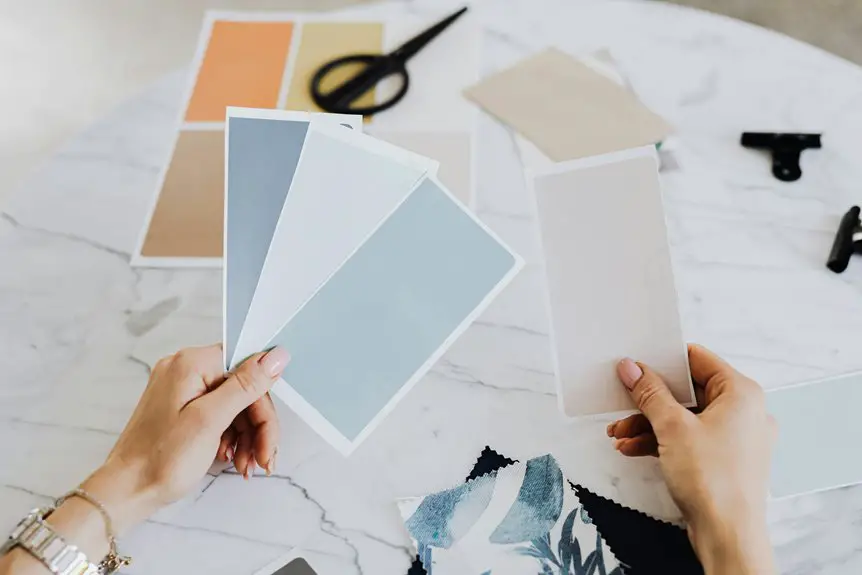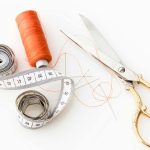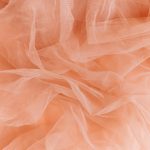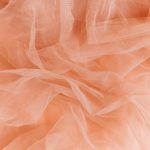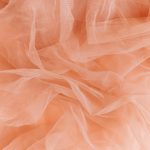To create your own crinkle gauze fabric, start with lightweight, breathable cotton gauze. Pre-wash it to remove finishes, then twist, scrunch, or pleat the fabric to form wrinkles. Set the texture by gently steaming or tumble drying on low heat, allowing it to cool fully to lock in creases. Avoid ironing or harsh washing to maintain that soft, textured look. Keep going to discover tips, care advice, and creative project ideas for your new fabric.
Table of Contents
Key Takeaways
- Choose lightweight, breathable cotton gauze or bamboo fabric for the best crinkle results and pre-wash to remove finishes.
- Use twisting, scrunching, pleating, knotting, or rolling techniques to create varied crinkled textures on the fabric.
- Set crinkles permanently by steaming with a low-heat iron, tumble drying on low, or applying fabric stiffener spray.
- Always cool the fabric after heat-setting to solidify the crinkles and test treatments on a small swatch first.
- Care for crinkle gauze by washing gently in cold water, air drying flat or hanging, and avoiding ironing or harsh detergents.
What Is Crinkle Gauze Fabric?
Crinkle gauze fabric is a lightweight, textured material known for its soft, breathable feel and distinctive wrinkled appearance.
Lightweight and soft, crinkle gauze fabric offers a breathable texture with a unique wrinkled charm.
When you work with it, you’ll notice how effortlessly it drapes, making it perfect for scarves, baby blankets, or summer clothing.
Its crinkled texture isn’t accidental—it’s created through a special weaving technique that gives the fabric a puckered look and adds dimension.
This texture also means you don’t have to iron it, saving you time and effort. Plus, the breathability keeps you comfortable in warmer weather.
If you want a fabric that’s both stylish and practical, crinkle gauze is an excellent choice.
You’ll appreciate how its unique feel and look set your DIY projects apart from ordinary fabrics.
Materials Needed for Making Crinkle Gauze
To make crinkle gauze, you’ll need the right fabric and a few essential tools.
Choosing soft, breathable materials like cotton or bamboo is key.
You’ll also want scissors, pins, and a sewing machine to get started.
Essential Fabric Choices
When selecting fabric for your project, you’ll want materials that naturally enhance the crinkled texture without losing softness or durability.
Cotton gauze is an excellent choice because it’s lightweight, breathable, and holds crinkles well. Muslin works similarly, offering a soft feel and good texture retention.
Linen can add a natural, rustic look with a bit more durability but may be less soft. Avoid synthetic fabrics like polyester, as they don’t absorb water well and won’t hold the crinkle effect effectively.
Opt for 100% natural fibers to guarantee the crinkles set properly during the washing and drying process. Choosing the right fabric upfront makes your DIY crinkle gauze more successful, giving you that perfect blend of texture and comfort.
Required Tools Overview
Although you’ve chosen the perfect fabric, having the right tools on hand is essential for achieving that signature crinkled texture.
You’ll need a quality sewing machine, preferably one with adjustable tension, to help set the crinkles properly. Sharp fabric scissors are a must for clean cuts without fraying. Pins or fabric clips will help keep layers aligned during sewing.
A steam iron is vital—not for pressing flat, but for controlled steaming that encourages the fabric’s natural puckering. Don’t forget a measuring tape for accuracy and a seam ripper to fix any mistakes quickly.
Finally, a spray bottle filled with water lets you dampen the fabric as needed. With these tools ready, you’ll be set to create beautiful, textured crinkle gauze fabric efficiently and effectively.
Choosing the Right Fabric Base
Since the foundation of your crinkle gauze fabric affects its texture and durability, you’ll want to select the right base material carefully. Choosing a fabric that responds well to crinkling guarantees your project turns out soft, breathable, and long-lasting.
Cotton gauze is a popular choice because it’s lightweight and absorbs treatments well. You might also consider blends for added strength or silk for a luxurious feel. Avoid fabrics that are too stiff or synthetic, as they won’t achieve that signature crinkled look.
Keep these points in mind when picking your fabric base:
- Prefer natural fibers like cotton or linen
- Look for loosely woven textures
- Avoid heavy or tightly woven fabrics
- Consider blends for durability
- Test a small swatch for crinkle response before starting
Preparing Your Fabric for Crinkling
Before you start crinkling, make sure you pick the right fabric—lightweight cotton gauze works best.
Always pre-wash your fabric to remove any finishes that might resist crinkling.
Then, dry it carefully to set the fibers just right for that perfect texture.
Choosing the Right Material
Selecting the right fabric sets the foundation for successful crinkle gauze projects. You want a material that naturally holds texture and responds well to manipulation.
Cotton gauze is a top choice due to its softness and breathability, making it ideal for wearable items. Linen and bamboo blends also work nicely, offering durability and a gentle drape.
Avoid fabrics with too much stretch or synthetic fibers that resist crinkling. Consider the weight as well; lightweight fabrics crinkle more dramatically, while heavier ones offer subtle texture.
Here’s what to look for:
- Natural fibers like cotton, linen, or bamboo
- Lightweight to medium weight
- Loose weave for easy manipulation
- Smooth surface for even crinkles
- Avoid polyester and spandex blends
Picking wisely guarantees your fabric crinkles beautifully every time.
Pre-Washing Techniques
Although you might be enthusiastic to start crinkling, you’ll want to pre-wash your fabric to remove any sizing or finishes that could hinder the texture from setting properly. Pre-washing also softens the fibers, making the crinkles more pronounced. Use cold water and a gentle cycle to avoid shrinking or damaging your fabric before you begin.
| Step | Action | Tip |
|---|---|---|
| 1 | Wash fabric cold | Use mild detergent |
| 2 | Avoid fabric softener | It can smooth fibers out |
| 3 | Rinse thoroughly | Remove all detergent |
| 4 | Spin gently | Prevent wrinkles before crinkling |
| 5 | Handle damp | Ready for crinkle setting |
Following these steps guarantees your fabric is perfectly primed for creating beautiful crinkle gauze.
Fabric Drying Methods
Once you’ve washed your fabric, drying it correctly is crucial to set the stage for crisp crinkles. The way you dry your gauze fabric directly influences the final texture and quality of the crinkles.
Avoid over-drying, which can make the fabric stiff and harder to work with. Instead, aim for a balance that keeps the fabric slightly damp to enhance natural wrinkling.
Here are key drying tips to follow:
- Lay the fabric flat on a clean surface to prevent unwanted stretching.
- Hang it loosely to allow air circulation without pulling the fibers.
- Avoid direct sunlight to prevent fading and weakening the fabric.
- Use a low heat setting if machine drying to keep texture intact.
- Remove fabric promptly once dry to preserve the crinkle effect.
These methods guarantee your fabric’s texture is perfectly primed for your DIY project.
Techniques to Create the Crinkled Texture
When you want to achieve the distinctive crinkled texture of gauze fabric, several effective techniques can help you create that signature look. You can manipulate the fabric by twisting, scrunching, or pleating. Each method gives a unique texture and depth. Using these techniques consistently across your fabric will guarantee an even crinkle pattern.
| Technique | How to Apply | Resulting Texture |
|---|---|---|
| Twisting | Twist fabric tightly | Spiral crinkles |
| Scrunching | Squeeze randomly | Natural, uneven folds |
| Pleating | Fold fabric evenly | Structured ridges |
| Knotting | Tie knots | Clustered puckers |
| Rolling | Roll and compress | Soft, wavy creases |
Experiment with these to find the perfect crinkle for your project.
Setting the Crinkles Permanently
Now that you’ve created the crinkles, you’ll want to set them permanently to keep that textured look.
You can use heat setting techniques or try different fabric treatments to lock in the folds.
Let’s explore how these methods work and which might suit your project best.
Heat Setting Techniques
Although the crinkles in your gauze fabric look great fresh out of the wash, you’ll want to heat set them to keep that texture permanent.
Heat setting locks the crinkles into the fibers, preventing them from relaxing during future washes or wear. To do this effectively, you’ll use controlled heat without damaging the fabric.
Here are key heat setting techniques you can try:
- Use a steam iron on a low to medium setting, pressing gently without stretching
- Place a thin cloth between the iron and fabric to protect delicate fibers
- Use a clothes dryer on a low heat cycle, tumbling with the fabric inside
- Employ a heat press if available, adjusting temperature and time carefully
- Allow the fabric to cool completely before handling to solidify the crinkles
With these methods, your crinkle gauze will maintain its charming texture long-term.
Fabric Treatment Options
Since crinkle gauze fabric naturally wants to relax over time, you’ll need to apply specific treatments to set those crinkles permanently.
One effective method is using a fabric stiffener spray, which locks in texture by coating the fibers. Simply spray evenly and let it dry completely.
Another option is steaming your fabric while scrunching it tightly; the combination of moisture and heat helps the material hold its shape.
You can also try soaking the fabric in a diluted starch solution before drying it in a crumpled form.
For a more durable finish, consider applying a textile medium mixed with fabric paint.
Whichever method you choose, test it on a small fabric piece first to guarantee it maintains the desired softness and flexibility without losing the crinkle effect.
Tips for Achieving Uniform Crinkles
When you want your crinkle gauze fabric to look consistent, paying close attention to the folding and drying process is key. You’ll want to create even folds and maintain them as the fabric dries to achieve uniform crinkles.
To help you get the best results, keep these tips in mind:
Keep these tips in mind for the best results with your crinkle gauze fabric.
- Fold the fabric in equal sections to maintain consistent crinkle size.
- Use gentle pressure when folding, avoiding overly tight creases.
- Secure folds with clips or pins to hold shape during drying.
- Let the fabric air dry completely without disturbing the folds.
- Avoid ironing or stretching until the fabric is fully dry to preserve the crinkles.
Following these steps will give your gauze fabric beautiful, uniform texture every time.
Common Mistakes to Avoid
If you want your crinkle gauze fabric to turn out beautifully, you’ll need to steer clear of some common mistakes that can ruin the texture.
First, avoid washing the fabric too aggressively; harsh agitation can flatten the natural crinkles. Don’t skip the drying step—air drying without properly scrunching the fabric will result in inconsistent texture.
Be careful when choosing your fabric; not all cotton gauze is suitable for crinkling, so pick one that’s lightweight and breathable.
Also, don’t overlook tension during sewing—too tight stitches can pull the fabric flat.
Finally, avoid ironing the crinkles out; if you must press, use a low setting and a pressing cloth to protect the texture.
Staying mindful of these pitfalls guarantees your crinkle gauze looks charming and authentic.
Caring for Your Handmade Crinkle Gauze
Maintaining the unique texture of your crinkle gauze fabric starts with proper care. You want to preserve its softness and signature crinkles without flattening or damaging the fibers.
Preserve your crinkle gauze’s softness and distinctive texture with gentle, careful handling to avoid flattening the fibers.
Always handle your fabric gently and avoid harsh treatments that could ruin the delicate texture.
To care for your handmade crinkle gauze effectively:
- Wash in cold water on a gentle cycle or hand wash.
- Use mild detergent, avoiding bleach or fabric softeners.
- Air dry flat or hang to dry, avoiding direct sunlight.
- Avoid ironing; if necessary, use a low heat setting with a cloth barrier.
- Store loosely folded or rolled to prevent crushing the texture.
Following these tips will keep your fabric looking fresh and beautifully textured for years to come.
Creative Project Ideas Using Crinkle Gauze
Many creative projects come alive with the soft, textured charm of crinkle gauze fabric. You can craft lightweight scarves that add a delicate touch to any outfit or sew breathable baby swaddles that keep little ones cozy.
Try making flowy summer tops or skirts; the fabric’s natural crinkle adds effortless style without extra effort. For home décor, create airy curtains or decorative pillow covers that bring softness and texture to your space.
You might even design reusable produce bags or eco-friendly gift wraps, combining sustainability with beauty. Don’t hesitate to mix colors and patterns, as crinkle gauze absorbs dye beautifully, letting you personalize every project.
With this versatile fabric, your creativity truly has no limits.
Frequently Asked Questions
Can Crinkle Gauze Fabric Be Dyed After Crinkling?
You can dye crinkle gauze fabric after crinkling, but the texture might affect color absorption unevenly. It’s best to test a small piece first to guarantee the dye takes well and maintains the fabric’s softness.
What Is the Best Thread Type for Sewing Crinkle Gauze?
You’ll want to use a lightweight polyester or cotton thread when sewing crinkle gauze. These threads offer strength and flexibility, preventing puckering or breaking while maintaining the fabric’s delicate texture and natural stretch.
How Long Does the Crinkle Effect Last With Regular Use?
You’ll find the crinkle effect lasts several months with regular use, but it gradually softens over time. To keep the texture, avoid heavy washing and drying; gentle care helps maintain that unique crinkled look longer.
Is Crinkle Gauze Suitable for Baby Clothing?
Think of crinkle gauze as a gentle hug for your little one’s skin. You’ll find it perfect for baby clothing—it’s soft, breathable, and cozy, keeping your baby comfy while adding adorable texture and charm.
Can Crinkle Gauze Be Recycled or Repurposed?
You can definitely repurpose crinkle gauze by turning it into reusable cloths, scarves, or quilts. Recycling options depend on the fabric content, but upcycling keeps it out of the landfill and gives it new life.
- Does Chiffon Fabric Stink - July 15, 2025
- Does Chiffon Fabric Affect the Economy - July 15, 2025
- Does Cotton Fabric Have a Nap - July 15, 2025

